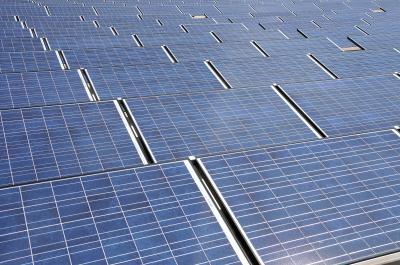A new technique for improving the connections between stacked solar cells could one day improve the overall efficiency of solar energy devices and reduce the cost of solar energy production.
Stacked solar cells consist of several solar cells that are stacked on top of one another. Stacked cells are currently the most efficient cells on the market, converting up to 45 percent of the solar energy they absorb into electricity.
But to be effective, solar cell designers need to ensure the connecting junctions between these stacked cells do not absorb any of the solar energy and do not siphon off the voltage the cells produce -- effectively wasting that energy as heat.
The new connections can allow these cells to operate at solar concentrations of 70,000 suns worth of energy without losing much voltage as "wasted energy" or heat.

Stacked solar cells are currently the most efficient cells on the market, converting up to 45 percent of the solar energy they absorb into electricity. But a new discovery will allow solar cell manufacturers to create stacked solar cells that can handle high-intensity solar energies without losing voltage at the connecting junctions, potentially improving conversion efficiency to better than 45 percent. Credit: Roger W. Winstead, North Carolina State University
"We have discovered that by inserting a very thin film of gallium arsenide into the connecting junction of stacked cells we can virtually eliminate voltage loss without blocking any of the solar energy," says Dr. Salah Bedair, a professor of electrical engineering at North Carolina State University and senior author of the paper describing the work.
Photovoltaic energy companies are interested in using lenses to concentrate solar energy, from one sun (no lens) to 4,000 suns or more. But if the solar energy is significantly intensified, to 700 suns or more, the connecting junctions used in existing stacked cells begin losing voltage. And the more intense the solar energy, the more voltage those junctions lose -- thereby reducing the conversion efficiency.
"Now we have created a connecting junction that loses almost no voltage, even when the stacked solar cell is exposed to 70,000 suns of solar energy," Bedair says. "And that is more than sufficient for practical purposes, since concentrating lenses are unlikely to create more than 4,000 or 5,000 suns worth of energy. This discovery means that solar cell manufacturers can now create stacked cells that can handle these high-intensity solar energies without losing voltage at the connecting junctions, thus potentially improving conversion efficiency.
"This should reduce overall costs for the energy industry because, rather than creating large, expensive solar cells, you can use much smaller cells that produce just as much electricity by absorbing intensified solar energy from concentrating lenses. And concentrating lenses are relatively inexpensive," Bedair says.
Citation: Joshua P. Samberg, C. Zachary Carlin, Geoff K. Bradshaw, Peter C. Colter, Jeffrey L. Harmon, J. B. Allen, John R. Hauser, and S. M. Bedair, 'Effect of GaAs interfacial layer on the performance of high bandgap tunnel junctions for multijunction solar cells',Appl. Phys. Lett. 103, 103503 (2013) DOI: 10.1063/1.481991





Comments